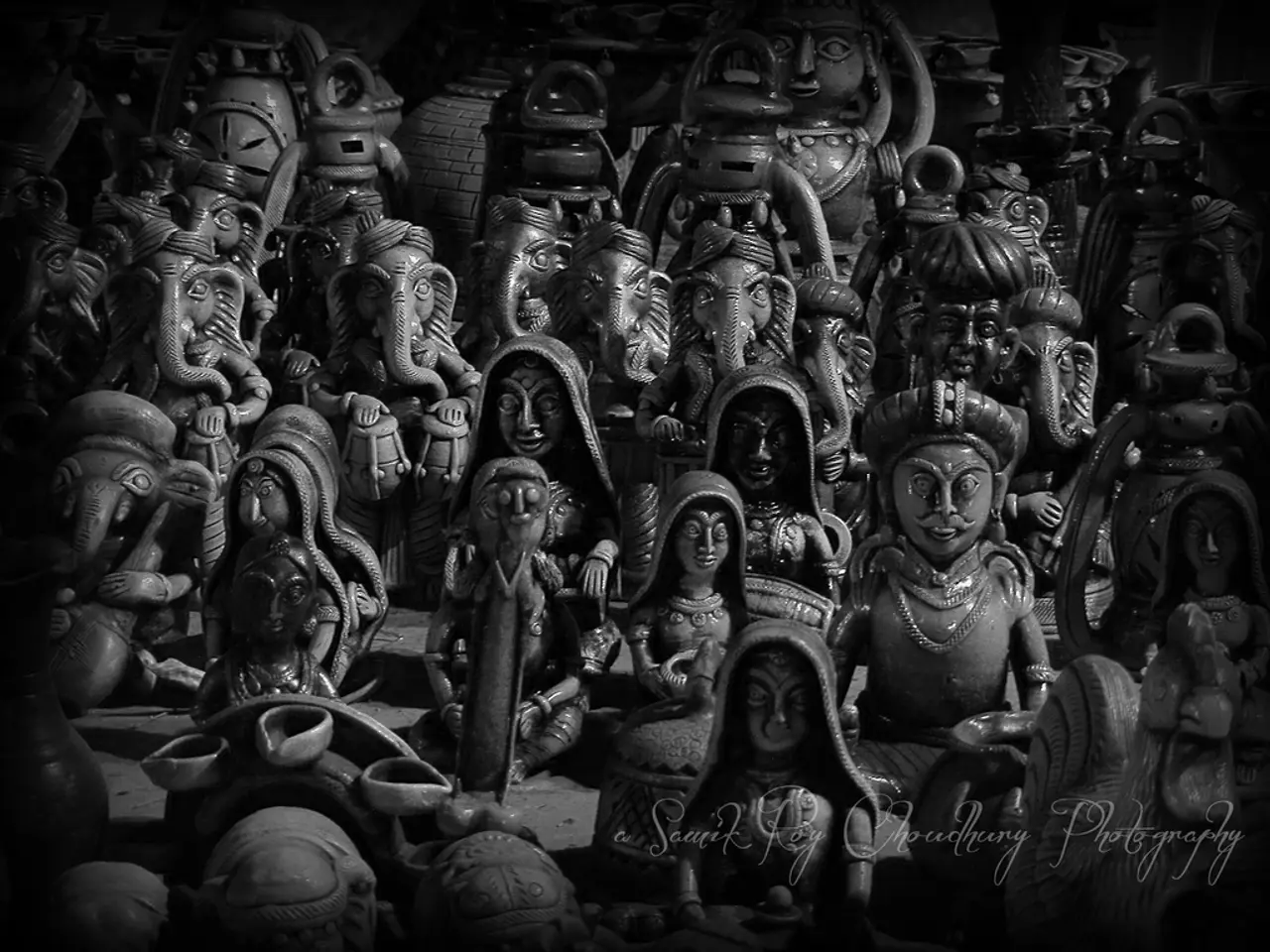The Reason Behind Teej's Observance
Celebrating Feminine Spirituality and Marital Devotion: The Festival of Teej
In North India and Nepal, the Hindu festival of Teej, particularly Hariyali Teej, holds a rich historical and cultural significance. This festival is a testament to the power of feminine spirituality and marital devotion, as it commemorates the divine reunion and marriage of Lord Shiva and Goddess Parvati [1][2][3].
Historically, Teej marks the day when Goddess Parvati completed a rigorous penance to win Lord Shiva as her husband, embodying the ideals of patience, devotion, and spiritual dedication [2][3]. This narrative is central to the festival’s fasting and worship practices, where women pray for a happy and prosperous married life and the long life of their husbands [2][3]. It is believed that unmarried women fasting on this day remove obstacles to marriage [1].
Culturally, Teej is deeply rooted in the social fabric of the northern Indian states like Rajasthan, Uttar Pradesh, Bihar, Madhya Pradesh, Haryana, and Nepal. Women celebrate with traditional songs, dances, swings, henna application, and exchanging gifts known as sindhara—homemade sweets, bangles, henna, and more—strengthening familial bonds and cultural identity [1][3].
The festival also coincides with the onset of the monsoon season, symbolizing fertility, renewal, and the rejuvenation of nature, which adds a seasonal agricultural significance to the celebration [3][4]. In regions like Rajasthan, the festival has additional historic connotations related to local legends and heroic acts associated with the day [1].
Teej is more than just a festival; it’s a spiritual journey, a cultural statement, and an emotional celebration. Each type of Teej is marked by fasting, prayers, music, dance, and rituals that honor Goddess Parvati and Lord Shiva [4]. Traditional songs during Teej celebrations celebrate love, separation, longing, and divine devotion [1].
Teej includes Hariyali Teej, Kajari Teej, and Hartalika Teej. Hariyali Teej, celebrated in the month of Shravan (July-August), focuses on marital happiness, especially popular in Rajasthan and Punjab [3]. Hartalika Teej, observed a day before Ganesh Chaturthi, marks the day Goddess Parvati was taken by her friend into the forest to escape an unwanted marriage and pray for Lord Shiva [1]. Kajari Teej, celebrated about 15 days after Hariyali Teej, mainly in Uttar Pradesh and Bihar, is linked to the health and prosperity of one’s husband [1].
Married women observe fasts and perform rituals on Teej to seek blessings for the well-being, longevity, and prosperity of their husbands. Unmarried girls fast and pray with the hope of finding a loving and caring life partner [1]. The central spiritual reason for celebrating Teej is to commemorate the reunion of Lord Shiva and Goddess Parvati [2].
On Teej, women dress in bright colors, apply mehendi, and gather for folk songs, dances, and storytelling. They exchange "Sindhara"- a gift hamper of sweets, clothes, and cosmetics-from their parents' home during Teej, further strengthening familial bonds and cultural identity [1][3].
In summary, Teej is a festival that honors female devotion to marital fidelity, celebrates the divine love between Shiva and Parvati, and reinforces women's social and cultural roles through ritual fasting, communal festivities, and seasonal celebration [1][2][3][4]. It serves as a celebration of feminine strength and resilience, offers a platform for women's voices and cultural expression, encourages the preservation of folk art, customs, and oral histories, and acts as a reminder to cherish relationships, values, and nature in a rapidly changing world.
[1] https://www.india.com/lifestyle/festivals/teej-festival-2021-date-history-significance-and-celebrations-4732537/ [2] https://www.thehindu.com/society/tradition-and-belief/teej-festival-celebrating-the-divine-marriage-of-shiva-parvati/article37830006.ece [3] https://www.thebetterindia.com/169126/teej-festival-celebration-history-mythology-significance-meaning-2021/ [4] https://www.deccanherald.com/specials/festivals/teej-festival-855811.html
- The world of social media can be a platform for showcasing Teej celebrations, allowing people from various corners of the globe to witness the cultural travel and deep-rooted traditions associated with the festival.
- In the realm of pop-culture, Teej could inspire fashion-and-beauty trends, as women dress in vibrant colors and adorn themselves with mehndi designs, reflecting the spirit of the festival.
- Relationships are at the heart of Teej, as married women seek blessings for their husbands' well-being and unmarried girls pray for a loving life partner, affirming the importance of family-dynamics in this spiritual journey.
- As part of the entertainment industry, dying a television show or movie around Teej could offer a unique blend of cultural travel, sci-fi-and-fantasy elements, and a narrative centered on marital devotion and feminine spirituality.
- Traveling to the regions of North India and Nepal during Teej can provide a cultural immersion, allowing visitors to experience the seasonal lifestyle, the communal festivities, and the incredible oral histories associated with the festival.
- In the broader scope of human life and social media, Teej can serve as a reminder to value relationships, honor tradition, and celebrate the strength and resilience of women, not just during the festival, but throughout the year.




